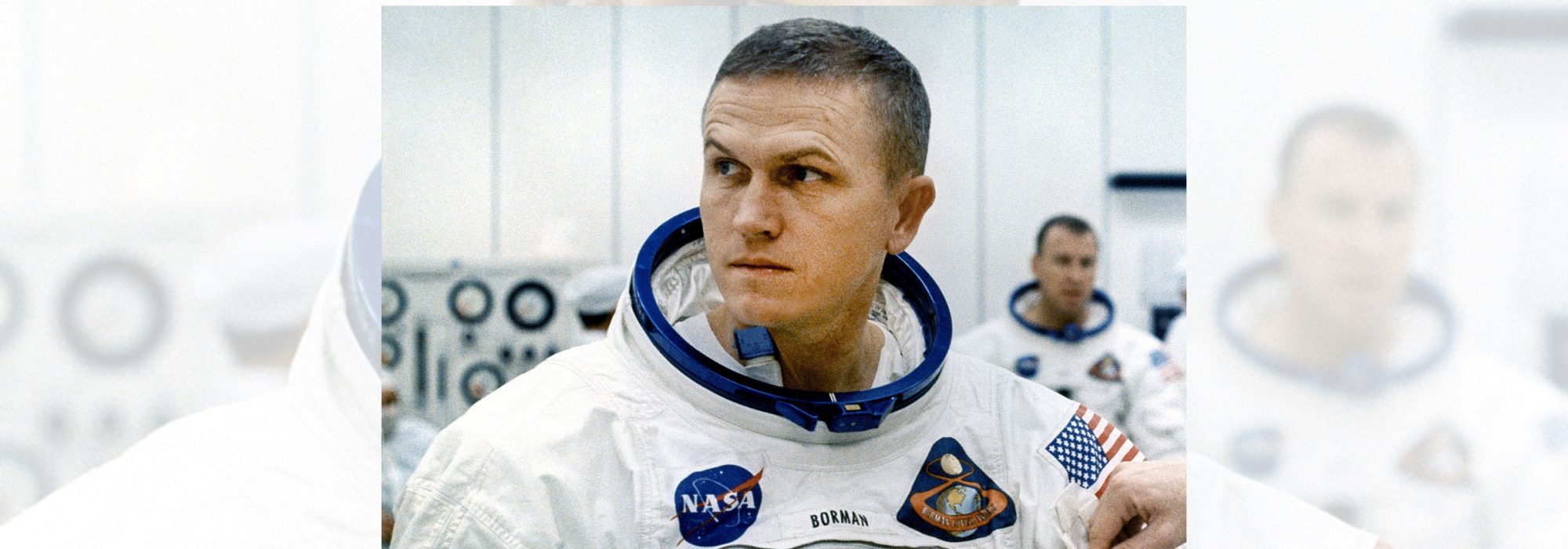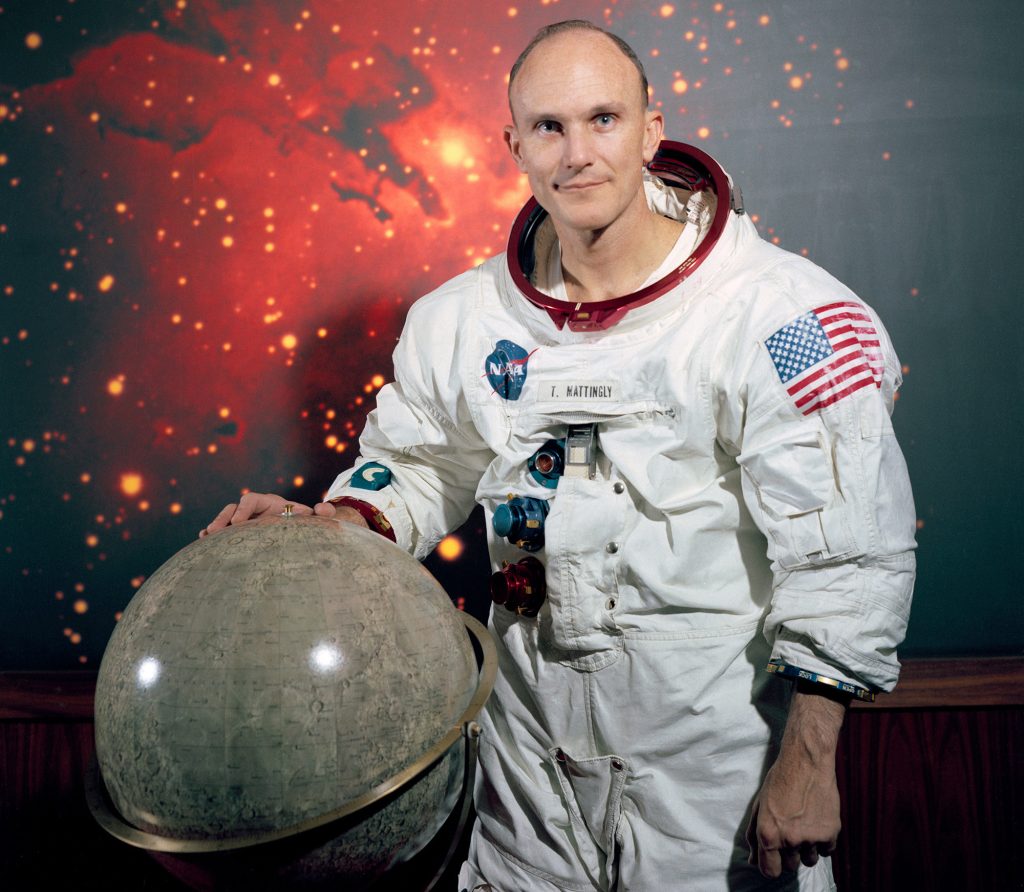Frank Borman, Apollo 8 Commander and USAF Pilot, Dies at 95
By John A. Tirpak
Frank Borman, Air Force fighter and test pilot, the American astronaut who commanded Gemini 7 and Apollo 8, and later head of Eastern Air Lines, died Nov. 7. He was 95.
The Apollo 8 mission, in December 1968, the first manned mission for the Saturn V rocket, marked the first time human beings traveled to and orbited the moon. The successful flight paved the way for the six U.S. moon landings that followed.
Borman learned to fly at 15, graduated West Point near the top of his class in 1950, and joined the Air Force, where he became an instructor and fighter pilot. He flew F-80s, T-33s, and F-84s. After earning a master’s degree in aeronautical engineering at the California Institute of Technology in 1957, he taught thermal dynamics and fluid dynamics at West Point for three years. He then attended the Air Force’s test pilot school and was involved in testing a number of new aircraft, including the F-104 in a series of “zoom” to high-altitude test flights.
In 1962, Borman was picked for the second group of astronauts, and went into rotation for the Gemini and Apollo flights.
As commander of Gemini 7, his first space mission, he shared for 14 days the cramped Gemini capsule with fellow astronaut Jim Lovell in 1965. That flight proved human beings could function in space—at least long enough to make it to the moon. In addition, the craft rendezvoused with Gemini 6, validating procedures needed for future space rendezvous and docking activities.
Less than two years later, the crew of Apollo 1—Gus Grissom, Edward White, and Roger Chaffee—were killed in a capsule fire while performing a launchpad “plugs out” check of their spacecraft. Borman was the sole astronaut on the review board formed to determine the root causes of the fire, which proved deadly because the design did not allow for the crew to escape on their own.
Borman helped persuade Congress to resume support for the Apollo program, testifying on the review’s findings and expressing confidence in the enterprise and its leadership. The fire, he said, was due to a “failure of imagination,” in which engineers had not fully anticipated every potential problem. He said NASA would learn from the tragedy.
Borman was then chosen to work with North American Aviation to correct the deficiencies and defects in the Apollo spacecraft and to help redesign the hatch so that future crews could escape quickly if necessary.
Picked to command Apollo 8, Borman accepted the challenge when the 1968 mission was changed. It was originally intended to be a deep-space test of the Apollo command and service modules with the lunar module. But the Soviet Union had achieved a lunar circumnavigation with a “Zond” unmanned craft earlier in the year, and intelligence indicated Russia might try to declare victory in the moon race by sending two cosmonauts on a similar flight in a Soyuz craft before the end of the year.
Viewing the situation as virtually a military battle, Borman took on the retooled mission, which allowed only a few months of training. Apollo 8, which made 10 lunar orbits, came off with virtually no technical glitches and confirmed the navigation techniques and computer software needed to go to the moon.
It was during that mission—flown by Borman, Lovell, and William Anders—that the famous “Earthrise” photo was taken of the small and fragile-looking Earth emerging over the lunar horizon, providing inspiration for the environmental movement and the creation of a national “Earth Day” less than two years later. The flight was also memorable for the crew’s reading from the Book of Genesis during a live broadcast from the spacecraft on Christmas Eve.
Borman was NASA’s liaison with the White House for Apollo 11 in 1969, and he coached President Richard Nixon to shorten his congratulatory message to the moon landing crew and a playing of the National Anthem, as it would consume precious extra minutes of the crew’s air.
Though offered command of a moon landing mission, Borman declined, saying he had no interest in lunar exploration and that he had simply viewed the moon race as a necessary military contest with the Soviet Union that the U.S. had to win.
He told an interviewer in 1999 that “as far as I was concerned, when Apollo 11 was over, the mission was over.” The science obtained on the five subsequent landings was “frosting on the cake.”
After leaving NASA, Borman visited 25 countries in 25 days as a special presidential envoy, seeking help from countries to pressure North Vietnam to release American prisoners of war. Borman returned with good wishes but no practical results. Invited to address a joint meeting of Congress to discuss the effort, he described the hardships of the captives, and urged lawmakers “not to forsake your countrymen who have given so much for you.”
He retired from the Air Force in 1970 as a colonel and soon joined Eastern Air Lines, becoming its senior vice president for operations. Five years later he became chief executive officer and the following year, chairman.
After Eastern, Borman operated an auto dealership with his son, and then became a cattle rancher in Montana. In 1996, with co-writer Robert J. Serling, he published his autobiography, “Countdown.” In retirement, he served on a number of corporate boards, including Home Depot and National Geographic.
NASA Administrator Bill Nelson said Borman “knew the power exploration held in uniting humanity when he said, ‘Exploration is really the essence of the human spirit.’ His service to NASA and our nation will undoubtedly fuel the Artemis Generation to reach new cosmic shores.”
Borman’s lengthy list of awards included the Harmon Trophy—twice, for Gemini 7 and Apollo 8—and the Collier Trophy for the Apollo 8 mission, along with Lovell and Anders; the U.S. Air Force Space Trophy; the Robert H. Goddard Memorial Trophy; the Congressional Space Medal of Honor and the Society of Experimental Test Pilots James H. Doolittle Award, as well as honorary doctorates from eight institutions of higher learning, including Air University.
Ken Mattingly, Apollo and Space Shuttle Astronaut, Dies at 87
By John A. Tirpak
Thomas Kenneth Mattingly II, command module pilot of Apollo 16, commander of two space shuttle missions, and an aerospace industry executive, died in Arlington, Va., on Oct. 31 at 87. He was one of only two astronauts to fly both an Apollo and shuttle mission in space.
Mattingly was commissioned in the Navy in 1958 and served as a pilot aboard aircraft carriers from 1960 to 1965. After completing the Air Force Aerospace Research Test Pilot School, he was one of 19 pilots selected in 1966 to be a NASA astronaut.
During his first five years with NASA, Mattingly supported the Apollo 8 and 11 missions and was the astronaut liaison to the industry/government team developing the Apollo space-suit and backpack.
He was selected for and trained as command module pilot of Apollo 13, but due to exposure to Rubella, was removed from the mission three days before launch. Replaced by backup astronaut Jack Swigert, he was on the ground when Apollo 13, en route to the moon, suffered an oxygen tank explosion in its service module, decimating the command and service modules’ power supply. Mattingly helped develop workarounds that allowed the service module to be used as a lifeboat so that the command module could conserve power for re entry. Despite his exposure, Mattingly did not become sick with Rubella.
Mattingly’s contributions to the ill-fated mission were recounted in the 1995 film “Apollo 13,” nominated for an Academy Award as Best Picture, in which he was played by actor Gary Sinise.
In a Nov. 1 statement, NASA Administrator Bill Nelson said Mattingly “stayed behind and provided key real-time decisions to successfully bring home the wounded spacecraft and the crew of Apollo 13.”
Back in the Apollo flight rotation, Mattingly was named command module pilot for Apollo 16, the penultimate moon mission, which sent astronauts John Young and Charles Duke to the lunar surface for three days in April 1972. Mattingly remained alone in the command module while they descended for the landing, conducting 36 experiments and mapping large swaths of the lunar surface.
On the return flight to Earth, Mattingly conducted a 73-minute extra-vehicular activity (EVA) to retrieve film canisters from the craft’s service module. To date, it is one of only three deep-space spacewalks conducted beyond geostationary orbit.
After the Apollo program, Mattingly became a key figure in the development, test, and operation of the space shuttle. From 1973 to 1978, he was head of the astronaut office to support the Space Transportation System (STS), at which point he became technical assistant for flight test of the program.
From December 1979 to April 1981, he headed the astronaut office ascent/entry group. Mattingly was the backup commander for the STS-2 and STS-3 missions, the second and third orbital test flights of the shuttle Columbia.
He commanded STS-4 in July 1982. The Columbia mission was the last of four test flights of the shuttle system, which completed 112 orbits of the Earth. It landed on July 4 at Edwards Air Force Base, Calif., where President Ronald Reagan greeted the returning Mattingly and pilot Henry Hartsfield. From June 1983 through May 1984, Mattingly headed the Astronaut Office DOD Support Group
In January 1985, Mattingly commanded STS-51C aboard Discovery, with a crew of five, the first dedicated military mission for the shuttle. The mission launched a secret payload using the Inertial Upper Stage booster from the payload bay. The mission remains largely classified.
During his years as an astronaut, Mattingly logged over 504 hours in space. He retired from NASA in 1985, but returned to the Navy, retiring as a two-star admiral the following year. He went on to be director of Grumman’s Space Station Support Division, headed the Atlas booster program for General Dynamics, and was a vice president at Lockheed, where he ran the X-33 space shuttle successor program later canceled by the Pentagon and NASA in 2001.
Mattingly held an aeronautical engineering degree from Auburn University, and received numerous aerospace awards and honors, including the Department of Defense and NASA Distinguished Service Medals, the Society of Experimental Test Pilots Ivan Kincheloe Award, the Navy Distinguished Service Medal, and the Johnson Space Center Certificate of Commendation and Group Achievement Award. He had accumulated over 7,200 flying hours, including more than 5,000 in jets.

